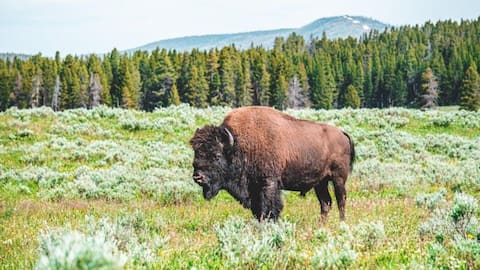170 bison could absorb CO2 from 2 million cars: Study
What's the story
A recent study suggests that a herd of 170 European bison, reintroduced to the Tarcu mountains in Romania, could absorb carbon emissions equivalent to nearly two million cars. This research, conducted by scientists at the Yale School of the Environment and funded by the Global Rewilding Alliance, is yet to be peer-reviewed. The study used a new model to calculate how wildlife species capture and store atmospheric carbon dioxide (CO2) in soils through their ecosystem interactions.
Bison reintroduction
European bison reintroduction in Romania
The European bison, extinct in Romania for over two centuries, were reintroduced to the southern Carpathian mountains in 2014. This initiative was a collaboration between Rewilding Europe and WWF Romania. Starting with just over 100 individuals, the herd has now grown to more than 170, making it one of Europe's largest free-roaming bison populations. The land could potentially support up to 450 bison.
Climate solution
Bison reintroduction: A nature-based climate solution
Alexander Lees, a biodiversity expert at Manchester Metropolitan University, supports the broader implications of bison reintroduction. He emphasized that this study presents a compelling argument for the reintroduction of European bison as a nature-based climate solution, one that offers significant co-benefits for biodiversity conservation. Magnus Sylvén, director of science policy practice at the Global Rewilding Alliance, highlighted the global significance of this research and its potential to influence climate policymakers worldwide.
Ecosystem balance
Bison's role in carbon capture and ecosystem balance
According to Professor Schmitz of the Yale School of the Environment, bison impact grassland and forest ecosystems through various mechanisms. He noted their role in grazing grasslands evenly, recycling nutrients to fertilize the soil, dispersing seeds to enrich the ecosystem, and compacting the soil to prevent the release of stored carbon. He emphasized that restoring these ecosystems can bring back balance. The study reveals that "rewilded" bison are some of the climate heroes that can help achieve this balance.
Carbon capture
Bison's grazing activities: A potential carbon capture solution
The grazing activities of bison across approximately 50 square kilometers of grasslands within the Tarcu mountains could potentially sequester an extra 2 million tonnes of carbon each year. This is equivalent to the emissions from about 1.88 million regular American cars running on petrol. Apart from their function in carbon capture, bison also play a substantial part in conserving biodiversity and fostering economic opportunities. This includes a surge in tourism and businesses centered around nature and rewilding initiatives.
